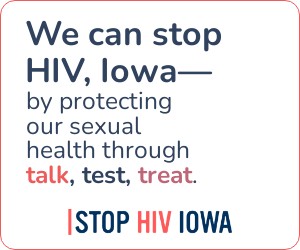Gangs of Des Moines
4/2/2014There was only one point in the past six months when I thought I was going to die.
I was sitting in a house on the south side of Des Moines with six Skinheads, discussing the “beat in” ritual for initiating new members. Midway through the conversation, a seventh member entered the house. He was a long-time ‘banger, older than the 19- and 20-year-olds I was talking to. After a brief moment’s reflection, I recognized him from high school. Though we moved in different circles back then, and I hadn’t seen him in 20 years, he recognized me, too. He asked me how I’d been, then joked about a time shortly after high school when my father (a now-retired Urbandale police officer) had pulled him over for drunk driving.
That was when the gun was put against my head.
This is one of those moments where it’s impossible to actually gauge beforehand how you’ll react. There are scenarios in our lives — a mugging, for example — that we’ll sometimes imagine in our heads over and over, and picture ourselves being heroic. Stoic. Laconic. Like in the movies. More often, though, if someday placed in the real situation, we wind up being less than those idealized visions of ourselves. I wasn’t heroic. Nor was I particularly cowardly. I just had the good sense to sit still.
“Are you recording?” asked a young man brandishing the weapon. I told him I was not. “Are you a cop?” I told him he already knew who I was.
After another tense moment, my former classmate told the young man to settle down, explaining that I was there asking questions for a story I was writing. He said, as long as I wasn’t a narc,that was good enough for him. The young Skinhead looked me in the eyes for an eternity in time, then put the gun back in the waistband of his pants and left the room.
“You have to watch out for the youngsters,” my former classmate said to me. “They’re hot-blooded.”
THE GANG COUNT
According to the Federal Bureau of Investigation, as many as 115 recognized gangs are currently operating within the state of Iowa. Of those, the Des Moines Police Department figures about 30 keep a measurable presence within Polk County, with half being heavily active inside Des Moines. Some local gangs may sound peculiar (The Really Cocky Asshole Killers; The Cool Kids; the Peckerwoods; Carney Pride), while others are among the most recognizable and notorious names in American violence, including Bloods, Crips, Vice Lords and Aryan Brotherhood. But the most active gangs within the confines of the capital city are C Block, their rivals, the Heavy Hitters and 18th St. and their rivals, MS13.
But what actually constitutes a gang? What are the hallmarks that make one group a bunch of random thugs and another an organized criminal organization? And what draws young men — because the numbers are overwhelmingly male and heavily African American and Latino — into a lifestyle rife with so much potential for violence?
 “In a lot of cases, boys who lack a sense of community will be drawn into gangs,” said Dr. Ehren Stover-Wright, Adjuct Professor of Sociology at Drake University. “But that’s an awfully simplistic answer. In a world where most conventional pathways to feeling like a man are closed, if you step into and completely commit to the gang culture, it gives you that pathway. The gang says, ‘This is what it means to be a man,’ and the child buys into that.”
“In a lot of cases, boys who lack a sense of community will be drawn into gangs,” said Dr. Ehren Stover-Wright, Adjuct Professor of Sociology at Drake University. “But that’s an awfully simplistic answer. In a world where most conventional pathways to feeling like a man are closed, if you step into and completely commit to the gang culture, it gives you that pathway. The gang says, ‘This is what it means to be a man,’ and the child buys into that.”
Simple, perhaps, but it’s an idea that’s at least anecdotally borne out.
“I always knew I wasn’t going to college,” said Deron, a 26-year-old self-professed member of the Gangster Disciples. “So this is how I step up. I do what I do — money in your pocket and the love of a family. If anything happens to me, Moms and my kids are gonna be looked out for.”
I point out: “If you weren’t in a gang, wouldn’t the chances of ‘something happening’ to you sharply decline?” He’s not buying.
“You don’t live where I live and know who I know without getting involved,” he said. “I didn’t go on Craigslist looking. It’s just right there. Everyone you know is in the gang. You don’t weigh no options. It’s just, ‘nigga, you in?’ And you don’t say no.”
VIOLENCE ISN’T THE ONLY MARKER
Wherever gangs are found, they make their presence felt. The FBI’s 2011 National Gang Assessment Report states: “Gangs are responsible for an average of 48 percent of violent crime in most jurisdictions.” It’s a shocking number and one that, frankly, could be well below the truth.
“The problem with identifying gang-related crimes is that a large percentage of it is gang-on-gang violence,” said DMPD Public Information Officer Sgt. Jason Halifax. “And most of the time, they aren’t talking (to the cops). So if a gang member gets shot or beaten, often times we’ll suspect it was a rival gang, but the victim won’t make a statement.”
For those not affiliated with a gang, Des Moines is a pretty chill place to live. Mention to the average city resident that there are more than a dozen gangs with large and active memberships operating in the city, and you’re apt to get surprised looks and general disbelief. This is, in part, because Des Moines’ gang activity tends to be fairly localized, Halifax said.
“If you’re not a member of one of these gangs, odds are you won’t come in contact with them,” Halifax explained. “Most of the crimes perpetrated by gang members are against other gang members, or people who associate with gang members.”

But violent crime isn’t the only way that gangs make their presence felt. In many large cities, one or more gangs control a significant portion of the drug trade. Des Moines, ideally situated at the intersection of two busy interstates, has more than its share of cocaine and marijuana that come through town, and the Midwest is a well known production site for highly addictive drugs like crystal meth.
“The common perception is of some redneck in a trailer somewhere, cooking this stuff in his bathtub,” said FBI spokesperson James Masters. “That’s usually not the case. The vast majority of the crystal methamphetamine being produced in Iowa and around the Midwest is under gang supervision.”

Sgt. Jason Halifax of the Des Moines Police Department stands on East High School campus.
Additionally, gangs have diversified their portfolios over the past 20 years to include more flesh-and-blood trade — everything from prostitution and human trafficking to alien-smuggling. According to the U.S. Department of Immigration and Customs Enforcement (ICE), as many as 10,000 people living and working in the state illegally were smuggled over the Mexican border by gangs.
All of this, however, hasn’t served to make the capital city a measurably more dangerous place to live. ICE has convicted one person in Des Moines for alien-smuggling in the past five years, with the majority of its efforts being focused in cities like Cedar Rapids and Dubuque. Even the drug trade — something that’s prevalent in an American city of any size — isn’t an overwhelming issue in Des Moines, according to officials.
“There’s certainly a market for drugs like meth in Des Moines,” said Stover-Wright. “But we’re seeing a lot more abuse of over-the-counter and synthetic drugs that can be bought legally in head shops and the like.”
LOOKING FOR SOLUTIONS
Nothing this complicated in life ever has a clear answer. Like most things, reasons for joining gangs will vary depending upon individual circumstances. When it comes to recruitment, organizations like the FBI and DMPD make a distinction between street-level gangs and organized criminal institutions like the Italian and Russian mobs.

Officials say students often join gangs for a sense of belonging and/or due to a lack of legitimate opportunities, such as education and work.
“If somebody sets out to be a criminal entrepreneur, they’re going to be seeking out the (criminal organizations),” Stover-Wright explained. “But it’s the gang community that seems legitimate to them. These kids aren’t out saying, ‘Oh, I’m going to join the Cosa Nostra.’ They’re going to join the gang that’s in their school. Police view those as the more dangerous ones.”
Indeed, law enforcement agencies around the nation have taken great pains to stymy street-level recruitment as much as they can and to eliminate the mystique that gang membership is perceived to carry.
“People used to be much more outspoken about their gang affiliation,” Halifax said. “But we’ve made just the act of being in a gang a crime, and that’s helped curtail a lot of the graffiti and wearing of gang colors that we used to see.
“If you just walk up and tell me, ‘I’m in this gang,’ I’m probably not going to arrest you. But if you commit a crime, especially a violent crime, and we discover your gang affiliation, that is very likely to carry a separate charge.”

Dr. Ehren Stover-Wright is the adjunct professor of sociology at Drake University
Iowa Code 723 states that participation in gangs is a Class D Felony, punishable by five years in prison and fines, if convicted. Participating in gang-recruiting activities is scheduled as a Class D or C, depending on age. Class C felonies are punishable by up to 10 years in prison.
But still, gangs persist. Many, especially those in poorer neighborhoods, see gangs as the only viable option for pride, success and survival.
“There’s a lot of research that suggests an inverse relationship between economic prosperity and criminal behavior of all kinds,” Stover-Wright said. “If people are prosperous, people don’t join gangs; they join clubs focused on their interests. In some ways, gangs are just clubs focused on criminal activity. But you don’t need to do criminal activity when you’ve got legitimate avenues (for success) open to you.”
Indeed, many of the gang members I spoke to referenced the sense of accomplishment they felt, making far more money from gang activity than they could through a 9-to-5 job.
“What am I going to do, work at McDonalds?” asked 22-year-old Terrell, an admitted Blood. “That’s embarrassing. My family eats. We’ve got a roof over our heads. My car is newer than yours. I’m not walking away from any of that.”

Iowa is among the average for gang population in the country, with about five gang members in every 1,000 people. That’s about 15,000 people in the state.
Source: Federal Bureau of Investigation
For many others, gangs instill a sense of community and belonging. Even groups like the Juggalos — who vehemently oppose the gang label — see their main connection being one of shared experience.
“People will look down on you and talk shit just because you like a band, or you like to dress a certain way,” said self-professed Juggalo Mike Williams, 29. “But when you’re with other Juggalos, everyone gets you. We watch out for one another, and if you get in trouble, the family has your back. That’s a good feeling.”
Economic, social and racial factors all weigh on the level of gang activity a given city is going to experience. In places like Des Moines, where the economic stratification is less pronounced than, say, New York City or Los Angeles, the effects of gang activity are much less pronounced. People typically feel safe walking Des Moines streets on a day-to-day basis.
But gang activity is indeed alive and well in Des Moines, and in cities all around the nation. And while there may never be a day where we live without their presence, the biggest factor in limiting their influence is increasing avenues of legitimate opportunity for young, minority and disenfranchised males.
“No kid that has a legitimate opportunity elsewhere is joining a gang,” Stover-Wright concluded. CV
















Gang were created originally created to protect themselves against white people. America and Britain are busy now genociding the Middle East.
Sam, how do explain the mafia and biker gangs? Members of both are white.